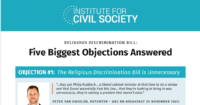On February 7, 2019, the Institute for Civil Society’s Prof. Mark Sneddon and Dr Simon Kennedy appeared before the Senate Constitutional and Legal Affairs Committee to further contribute to their inquiry into the Sex Discrimination Amendment (Removing Discrimination Against Students) Bill 2018. The Committee was appreciative of ICS’s contribution to the inquiry and asked a number of questions. Some of the responses were provided in writing and appear below.
Question 1. SENATOR MacDONALD AND SENATOR PATRICK asked whether teaching students in a religious school that sexual intercourse outside of man-woman marriage is sinful or that gender is fixed not fluid could amount to subjecting a student to “any other detriment” and hence constitute discrimination under the Sex Discrimination Act s.21 if the current exemption for religious education bodies in section 38(3) was removed as proposed in the Bill.
Short Answer
Existing case law is that a statement which insults, humiliates or demeans a person by reference to their race and results in psychological harm can amount to the imposition of detriment and thus discrimination. Existing cases are based on language which was viewed as insulting or demeaning to a person based on their race or ethnic origin. There has not been a court case applying this to teaching religious beliefs in religious schools, probably because of exceptions like sections 38(3) and 37. There is a high risk that if sections 38(3) and s.37 were amended by the Bill, the existing case law would be applied by a court or tribunal to hold that if teaching religious doctrine of the type described in the question insulted or humiliated or demeaned a student on the grounds of sexual orientation or gender identity (e.g. because the student was gay or lesbian or transgender or transitioning) and the student suffered psychological harm as a result (such as distress or depression), such teaching could amount to imposing a detriment and be prohibited under s.21.
Note that discrimination claims in such a case might be direct (e.g. if there was a particular teaching interchange between a teacher and the affected student) in which case there would be no reasonableness test defence under s.7B), or could be indirect discrimination if it was based on general teaching material provided to all students in which case there would be a reasonableness defence under section 7B.
To avoid these outcomes either the current exemptions need to be retained or an alternative protection along the lines of the proposed new section 7F needs to be added. As we noted, section 7F is not a perfect solution because it does not deal with issues arising outside the teaching context (e.g. refusal of a student club or protest meetings advocating for sex outside marriage). We reiterate that these issues require careful balancing and not a rushed solution.
A more detailed note on the case law appears below.
Longer Answer
If the exemption in section 38(3) were removed then such claims would almost certainly be brought against religious schools and adult education colleges and there would be messy factual disputes about what was actually said in the class and the tone and then a question of whether it should be interpreted as insulting or humiliating or demeaning. Acknowledging that what a teacher says and intends is not necessarily the same as what a student hears and interprets at the time or what a parent or third party hears and interprets on a second or third hand re-telling or what any of them remember later, feelings could run high and the real facts may be very difficult to determine. The potential for claims which in substance objected to the content of the doctrine or beliefs taught rather than the way it was taught is high.
Some Anti-Discrimination Commissions and Administrative Tribunals have shown themselves very willing to take on cases where offence was taken by a complainant to a stated opinion of the person complained even though the statement was measured and balanced – the real offence was to the content of the idea not how it was expressed. For example the Tasmanian ADC took on complaints against Bishop Porteous about the Catholic Bishops booklet Don’t Mess with Marriage (and two other complaints about standard Christian teaching on sex and family). The WA ADC took on a complaint against wedding photographer Jason Tey who did not refuse to serve a gay couple but told them, in case they did not wish to use him, of his Christian beliefs about God’s design for family structure. The couple demanded a public apology on Tey’s website for the offence they said they had suffered. The WA State Administrative Tribunal then took on the case after Tey refused to give the apology. In both cases the complainant eventually dropped the complaint but after many months of expensive and time consuming legal and conciliation processes. And in the different context of section 18C under the Racial Discrimination Act the AHRC took on complaints against 4 QUT students that their Facebook comments amounted to racial vilification. The AHRC took on the complaint for conciliation for 15 months. A Federal Court judge later held (3.5 years after the events) that an ordinary and reasonable Aboriginal person would not be reasonably likely to find the student’s statements offensive, insulting, humiliating or intimidating and dismissed the case.
The very likely result of removing the exemptions in section 38(3) and 37 is that some students or their parents or adult students will bring a complaint that teaching of the type described in the question was insulting or demeaning and created detriment in the form of psychological harm and was therefore prohibited discrimination. It is very likely that the Australian Human Rights Commission would accept such a complaint and conduct a conciliation process involving time and cost and the risk of adverse media for the teacher and school. Some complaints might be meritorious (that is they involve real bullying or intimidation by a teacher although the current evidence that such conduct occurs is very limited and much of it is uncorroborated and contradicted by schools). Some complaints will be solely based on student or parent offence at the content of the religious doctrine or belief, not the manner of its delivery, and the effect of those complaints will be to intimidate and chill the expression by teachers and religious schools of religious teaching which some students or parents disagree with.
As a policy comment, in our view, opening up an avenue for discrimination complaints because a student or parent is offended or hurt purely by the content of religious beliefs taught in religious schools (not by the manner in which they are taught) is just inviting legal warfare and community division. That feelings may be hurt or offence taken simply because we hear a different worldview to our own is understood but accepting that is part and parcel of living in a pluralist democracy with basic liberal freedoms of belief and speech for all.
If there was real targeted bullying or humiliating behaviour by a teacher towards a student (on any grounds) there are existing internal and external avenues for recourse. All schools have anti-bullying policies and complaints procedures as required by State school registration bodies. No religious or other independent school is going to defend real bullying, if for no other reason than to protect its reputation and fee income in a competitive market. If necessary, such complaints can be escalated beyond the school to the relevant religious education system (e.g. Catholic Education Commission or Independent Schools Association in the State or Territory) and the school can be sued for breach of a duty of care and breach of contract.
Comment on the AHRC evidence
We were asked about the comments of the Australian Human Rights Commission on this issue. The relevant Hansard extract for 7 February is as follows.
Senator PATRICK: I’m trying to get to the next point. If that were not discrimination and we went to a different circumstance, where a teacher then said, ‘In accordance with our faith, marriage is between a man and woman and anything else is a sin,’ is there a difference between those two statements? We heard examples in the inquiry yesterday, where one of the witnesses suggested that might be what is taught. I’m trying to work out whether any of those give rise to a discrimination claim.
Mr Santow: The short answer to your question is that religious schools are permitted under Australian law to teach in accordance with their doctrines, tenets and beliefs. If what you’re describing is in accordance with doctrines, tenets and beliefs, then that is permissible under Australian law.
Senator PATRICK: So, under the changes, if this legislation is implemented and I stood up in a class and I said, ‘In accordance with our faith, marriage is between a man and a woman and same-sex marriage is a sin,’ that is not discrimination?
CHAIR: That’s a very important question. If you can give an answer, we’d appreciate it, but I suspect you might want to think about it.
Mr Santow: We do. The problem for us as a body that receives complaints is that, unfortunately, it would really depend on the surrounding circumstances, but the general principle holds: it will not change if this bill is passed. That is that religious schools will be able to teach in accordance with their doctrines, tenets and beliefs. It is certainly possible to imagine a scenario where that teaching goes beyond explaining what their religious text states and may actually discriminate against a school child. I think it’s absolutely clear that the community does not want that. It’s also clear that—
CHAIR: I suspect, Mr Edgerton, that as a lawyer you might have a slightly different view on the scenario that Senator Patrick gave. If a teacher gets up and says, ‘It’s a sin, according to the faith, to have a same-sex marriage,’ I just think you might want to think about—
Mr Edgerton: No, I completely agree with what the Human Rights Commissioner said.
CHAIR: It’s not contrary to this bill? Mr Edgerton: It sounds to me like that’s just an accurate description of the doctrine of the particular faith, but, if there are other surrounding circumstances that mean—
Senator FIERRAVANTI-WELLS: So was Archbishop Porteous—
Senator PRATT: That’s Tasmanian law, not Australian law. CHAIR: You’re your own bosses, but I’d hate you to be quoted in a court case sometime in the future, saying—
Senator FIERRAVANTI-WELLS: [inaudible] categorical assurance, you’d better be very clear about it. Mr Edgerton: The Human Rights Commissioner said that all of these situations depend on their own facts, but if it’s limited to just describing what is part of a religious doctrine of an organisation—
CHAIR: Saying to kids, ‘Your parents are living in sin’?
Senator PRATT: That might be individualised discrimination. Mr Edgerton: As soon as you start adding other things that aren’t really about—
Senator PRATT: That becomes direct discrimination.
Senator O’NEILL: This is why it’s complex and why we shouldn’t rush it.
Comment: Mr Santow and Mr Edgerton asserted that the “general principle” under Australian law is that religious schools are able to teach in accordance with their doctrines, tenets and beliefs and that that principle holds and it will not change if this bill is passed. We consider that statement is wrong. The Bill dramatically changes the “general principle” by removing section 38(3) and amending s.37.
The AHRC witnesses do not state the legal source of the “general principle”. There is no statute which creates that general principle. At best the AHRC may mean that there is a general common law freedom to speak and teach as one wishes subject to any legal restrictions. But any such common law “general principle” is subject to statute. And the general principle is restricted for educational institutions in section 21 of the Sex Discrimination Act which makes it unlawful to impose a detriment on a student on the basis of a protected attribute including by imposing such a detriment through teaching. It is the exemptions in section 38(3) and 37 which remove the limitation created by section 21 and protect the common law “general principle”. But if those exemptions are removed by the Bill, then the general principle will be limited by section 21 and if teaching in a religious education institution creates a detriment, it is prohibited. It is quite wrong to say that Bill will have no effect on the freedom of religious education institutions to teach their doctrines, tenets or belief – if that teaching amounts to “imposing a detriment” the Bill turns what is currently lawful into something unlawful.
Note on the Case Law
This note considers the question of whether a student (particularly a transgender or gay student) could have a detriment imposed on them in a faith-based school simply because that school teaches its orthodox view of marriage, or sexuality or gender identity. These issues are yet to make it into courts. The existence of the religion exemptions like section 38(3) is likely to have prevented such cases from being litigated. Accordingly the case against removal of an exemption for direct discrimination simply cannot be made on the basis that there is no litigation that has arisen (which is a consequence of the exemptions).
The question then is about the (currently hypothetical) application of the prohibitions in section 21 to a school that teaches a traditional view of marriage. As the notion of ‘detriment’ is reasonably well developed at law, we can reason from those principles, applying them to the specific context of the proposed law.
1. Section 21 of the SDA provides:
(2) It is unlawful for an educational authority to discriminate against a student on the ground of the student’s sex, sexual orientation, gender identity, intersex status, marital or relationship status, pregnancy or potential pregnancy, or breastfeeding:
(a) by denying the student access, or limiting the student’s access, to any benefit provided by the educational authority;
(b) by expelling the student; or
(c) by subjecting the student to any other detriment. (emphasis added)
2. In considering the content of the notion ‘detriment’ in Varas v Fairfield City Council,[1] Graham J applied the following statement of Brandon LJ in Ministry of Defence v Jeremiah:
I do not regard the expression ‘subjecting …to any other detriment’ as used in section 6 (2) (b), as meaning anything more than ‘putting under a disadvantage’.[2]
Applying this principle, her Honour held that to suffer a detriment a person has to have been put under a disadvantage, the disadvantage must be a matter of substance and not directed to trivial distinctions, and that the test is an objective one.
3. In Hautlieu Pty Ltd t/a Russell Pathology v McIntosh[3] McKechnie J held that the notion of ‘detriment’ could include psychological injury:
“Detriment” is defined by the “Macquarie Dictionary” as “loss damage or injury”. “Injury” is harm of any kind done or sustained or a wrong or injustice suffered. Clearly “injury” can take many forms and is not limited to physical harm. Psychological damage may amount to an injury.[4]
4. Various judges have acknowledged that in certain contexts mere words can amount to discrimination. In Nationwide News Pty Ltd v Naidu Basten J recognised ‘racially abusive epithets of a kind … could readily give rise to a racially hostile working environment. Like cases of sexual harassment, racial harassment of that kind would also be unlawful’ as racial discrimination.[5] Similarly in Qantas Airways v Gama the Full Court of the Federal Court held that ‘remarks [by fellow employees] which are calculated to humiliate or demean an employee by reference to race, colour, descent or national or ethnic origin’ could amount to discrimination.[6] Similarly, in Singh v Shafston Training One Pty Ltd and Anor[7] it was held that racially ‘insulting’ comments directed against an employee in front of his peers could comprise discrimination. There the complainant asserted that the comments made against him on the basis of his race:
caused him significant distress, disturbance to his concentration, and from time to time, poor appetite and sleeping habits. He says that he has been diagnosed with depression as a result.[8]
5. Drawing these various authorities together it is clear that verbal statements can amount to a form of discrimination where they ‘insult’, ‘humiliate or demean’ in a way that creates psychological harm. While this reasoning is yet to be applied to the context of religious schools (because of the presence of the existing exemptions), Ronalds and Raper acknowledge that ‘[t]he concept of “detriment” in the education provisions of the discrimination laws could cover any such harassment that resulted in a hostile educational environment.’[9] In light of this array of authority, if the exemption were to be removed, it is clear that the conditions exist for a claim that asserts that a child had been subject to a detriment where teaching affirming the traditional view of marriage, gender identity and sexuality was provided. With a suitable set of circumstances, it is readily foreseeable that a court could objectively determine that a child who had publicly identified as gay or of a gender differing from their biological sex had been treated detrimentally in front of their peers through the provision of such teaching. Even where the child’s peers are not aware that the child is gay or transgender, many psychologists hold the view that such teaching imparts psychological harm. These matters would then turn on the evidence before the Court and the view of the judge.
6. The assertion that such teaching could impart psychological harm is not novel – it is made in several submissions to this inquiry. To demonstrate the prospect of such a claim, one need only look to the application of such principles within existing the (non-exempt) public school sector. There are existing examples of Departmental reviews of religious instruction materials that have required providers modify their teaching on sexuality. Last year the Guardian reported that a Departmental review of religious instruction material in New South Wales found:
Although these particular examples may represent the world view of the faith group, some passages seem to be insensitive to the psychological welfare of students (for example, those associating cancer with sin, or discussing diverse sexuality) and broader community norms.[10]
There is every reason to think that the same secular perspectives favouring non-offence and sensitivity over religious beliefs over could be applied to a faith-based school by a secular Court considering a claim for psychological damage from a student subjected to traditional teaching. The removal of the exemption will open the door to that.
7. From the publicly available reporting, it is just such a claim that was made against Jason Tey in the Western Australian Equal Opportunity Commission. According to the Australian:
Christian wedding photographer Jason Tey was taken to the West Australian Equal Opportunity Commission after he agreed to photograph the children of a same-sex couple but disclosed a conflict of belief, in case they felt more comfortable hiring someone else. At the conciliation hearing, it was demanded that Mr Tey provide an admission of discrimination as well as a written apology to be published publicly on the homepage of his website and all social media pages associated with his photography business for at least two months.
Mr Tey, 36, said: “I don’t believe that I have discriminated in any way, neither offered unfavourable treatment. I merely stated that I have a contrary view due to my Christian faith.”[11]
The assertion is that by Mr Tey’s statement imposed a detriment on the couple. From the reporting it appears that the Mr Tey’s statement had no public dimension, that is, it did not occur in the presence of the applicant’s peers.
8. Another relevant decision is that in NC v Queensland Corrective Services Commission, where Keim M considered that the ‘singling out’ of prisoners living with HIV/AIDS amounted to a detriment:
In seems to me that subjective factors are very important in cases under the ADA [Qld]. Frequently, the mere fact of being treated differently because of one’s impairment (or other defined attribute) will constitute by itself unfavourable treatment. This does not mean that objective reality is not important. The person is not discriminated against simply because he or she perceives himself or herself to be treated differently.
However, where a person is in fact treated differently, then that different treatment will, on occasion, be capable of being unfavourable treatment because it is different. The very fact of being singled out will and will be perceived as being an unfavourable way of treating the person in question. Singling out does not have to involve less comfort, less food or less money to be unfavourable.[12]
Thus the perception of the complainant was relevant where a singling out had objectively occurred. As noted above, it is readily open to conclude that such a ‘singling out’ could arise where the teaching of traditional beliefs occurs in a class containing a child that had publicly identified as gay or gender diverse.
9. The question of a child’s perception of detriment may also be relevant for the determination of the applicable damages to be awarded. In Clarke v Catholic Education Office[13] it was held:
As a child, it is very likely that he would and did register the respondents’ attitude as one of rejection of him on account of his deafness, even though the disinterested adult can see that the position was much more complex than that. That would have been hurtful.
This was upheld by the Full Federal Court in Catholic Education Office v Clarke.[14]
10.
- The Victorian Equal Opportunity Commission considers that the failure to publicly recognise a person’s preferred gender identity may comprise discrimination.[15] In most cases, such would comprise direct discrimination, not indirect discrimination. Similarly, teaching that the only proper expression of sexuality is within heterosexual married relationships could be regarded as direct discrimination targeted at students who are known to be same sex oriented or are being raised by a same sex couple. Teaching that gender is assigned at birth to correspond with biological sex could be regarded as direct discrimination targeted at students who are known to be is also not neutral. Neither example falls within Justices Dawson and Toohey’s description of indirect discrimination: ‘where one person appears to be treated just as another is or would be treated but the impact of such “equal” treatment is that the former is in fact treated less favourably than the latter.‘[16] Even if a court were to hold that such teaching was indirect discrimination, on the above analysis, such teaching is unlikely to fall within the bounds of ‘reasonable’ conduct permitted by section 7B without the inclusion of additional provisions such as the proposed amendment inserting section 7E.
Question 2 SENATOR MACDONALD. If the federal Sex Discrimination Act provides that there is no discrimination in a certain case because of an exemption but State law like the Queensland or Tasmanian anti-discrimination laws provide that the same case is prohibited discrimination because they do not have the exemption which her federal law contains, does the federal law override the State law?
The short answer is yes if there is a direct inconsistency because the federal law expressly permits the same conduct which the State or Territory law makes unlawful, the federal law overrides the inconsistent State law to the extent of the inconsistency under s.109 of the Constitution (and overrides the Territory law under the equivalent provisions in the Territory’s self-government Acts).
The Sex Discrimination Act section 10(3) provides that the Act is not intended to exclude or limit the operation of a law of a State or Territory that is capable of operating concurrently with the SDA. But that provision does not deal with a direct inconsistency between federal and State anti-discrimination laws as proposed in the question.
Where the State anti-discrimination law prohibits the same conduct by the same person which the federal SD Act expressly permits (because of an exemption in the federal Act) there is a direct inconsistency and the State law is rendered inoperative to the extent of the inconsistency. The State law removes or limits a right or freedom conferred by the federal law. As the High Court said in Dickson v The Queen [2010]:
When a State law, if valid, would alter, impair or detract from the operation of a law of the Commonwealth Parliament, then to that extent it is invalid.
Rees, Rice and Allen in their text Australian Anti-Discrimination and Equal Opportunity Law (2018) Federation Press at para 2.14.24-25 address exactly a conflict between s.38 of the Sex Discrimination Act and the Queensland and Tasmanian Anti-Discrimination Acts. They conclude that the State laws are vulnerable to a s.109 inconsistency challenge.
Professor Neil Foster is of the same opinion – see https://lawandreligionaustralia.blog/2016/10/02/some-of-victorias-inherent-requirements-amendments-may-be-unconstitutional/
[1] [2009] FCA 689 at [32-36]
[2] [1980] QB 87 at 99.
[3] [2000] WASCA 146 (26 May 2000)
[4] Ibid, paragraphs 165-7.
[5] Nationwide News Pty Ltd v Naidu; ISS Security Pty Ltd v Naidu [2007] NSWCA 377 [378] Basten J.
[6] (2008) 157 FCR 537, [78].
[7] [2013] QCAT 008 (ADL051-11) Michelle Howard, Member 8 January 2013.
[8] Ibid, paragraph 5.
[9] Chris Ronalds and Elizabeth Raper Discrimination Law and Practice (4th edition) (2012), Federation Press, 81.
[10] https://www.theguardian.com/australia-news/2017/apr/12/nsw-rejects-some-religious-education-review-findings-but-will-scrutinise-material.
[11] ‘Religious freedom lost as White magazine shuts’ The Australian, 16 November 2018.
[12] NC v Queensland Corrective Services Commission [1997] QADT 22.
[13] (2003) 202 ALR 340.
[14] (2004) 138 FCR 121.
[15] https://www.humanrightscommission.vic.gov.au/home/our-resources-and-publications/eoa-practice-guidelines/item/632-guideline-transgender-people-at-work-complying-with-the-equal-opportunity-act-2010
[16] (1991) 173 CLR 349, 392.








Recent Comments